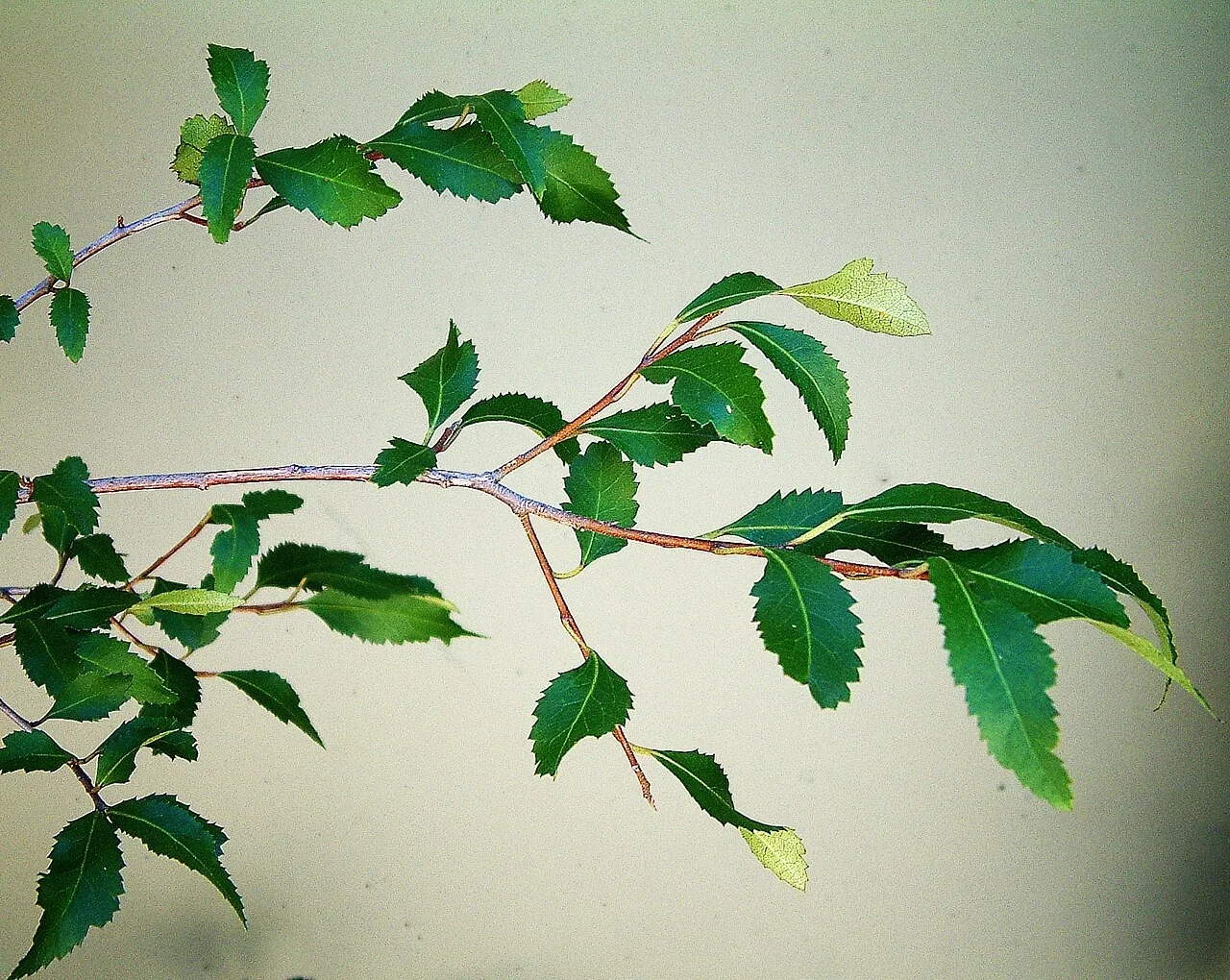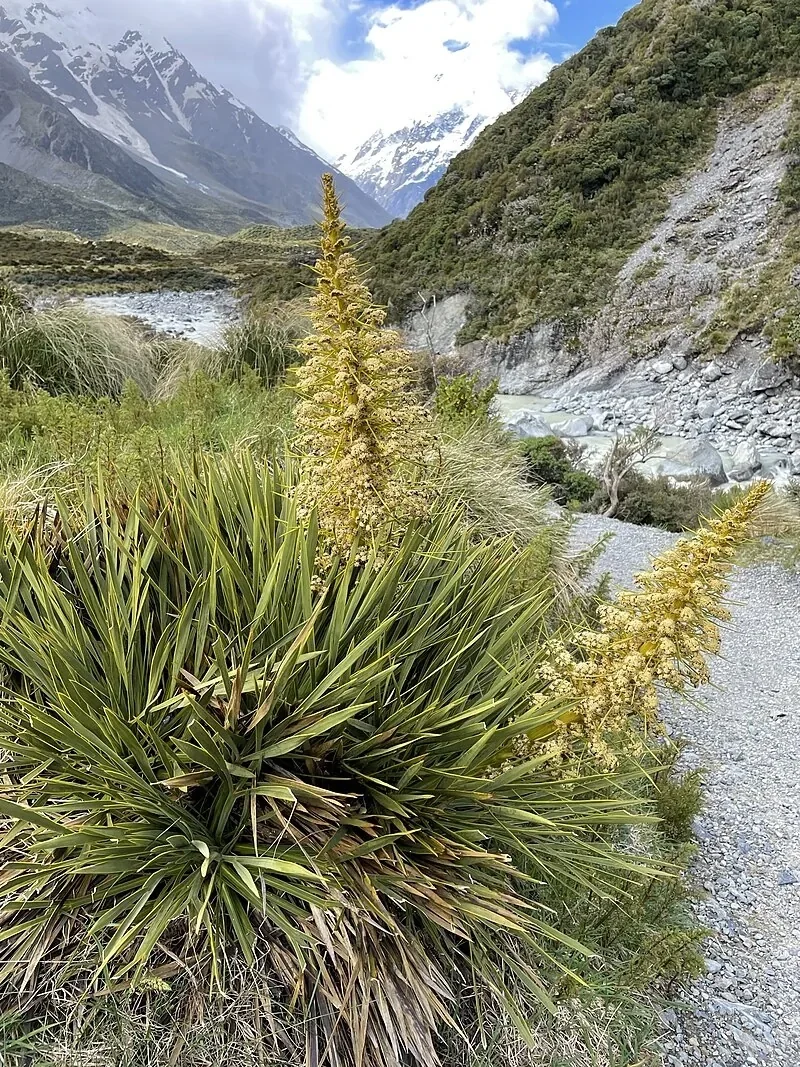
Ribbonwood
Plagianthus regius
A fast-growing, partially deciduous native tree with a graceful habit and spring bloom. Excellent for quick shelter and restoration. Learn more in our native plants guide .

Plant Description
Botanical Features
Ribbonwood ( Plagianthus regius ), also known as lowland ribbonwood or mānatu, is a deciduous or semi-evergreen tree endemic to New Zealand. It is considered the tallest deciduous tree indigenous to New Zealand, typically growing to 15-20 meters, with some specimens reaching 25 meters. It exhibits heteroblasty, meaning it has distinct juvenile, intermediate, and adult growth forms. Juvenile plants are often bushy with dense, slender, interlacing, zigzag branchlets and small leaves, typically 7-15 mm long, often with 3-4 large lobes at the tip, resembling a duck's foot. Mature plants transition to a more typical tree form with a single trunk and much larger, leathery, oblong leaves, about 5 cm long by 3 cm wide, which can be opposite, alternate, or whorled. One of its most distinctive features is its smooth, grey bark that peels in thin, ribbon-like strips, giving it the common name "ribbonwood." In spring (September-November in New Zealand), it produces dense clusters of small (3-4 mm diameter), cream-coloured to yellowish or greenish-white flowers that can be subtly fragrant.
Quick Facts
Overview
| Scientific Name | Plagianthus Regius |
|---|---|
| Height | 10-20 m |
| Spread | 6-10 m |
| Light | Full sun |
| Water Needs | Moderate |
| Frost | Good |
| Frost Tolerance | Hardy once established |
| Salt Tolerance | Low; requires protection from salt exposure |
| Growth Rate | Fast growing |
| Lifespan | Long-lived |
Climate Best Suited to
Regional climate suitability across major New Zealand cities.
Regional Suitability
| City | Climate Suitability |
|---|---|
| Whangārei | Ideal |
| Auckland | Ideal |
| Hamilton | Ideal |
| Tauranga | Ideal |
| Rotorua | Ideal |
| Gisborne | Ideal |
| New Plymouth | Ideal |
| Napier | Ideal |
| Whanganui | Ideal |
| Palmerston North | Ideal |
| Wellington | Ideal |
| Nelson | Ideal |
| Christchurch | Ideal |
| Dunedin | Ideal |
| Invercargill | Ideal |
Natural Habitat
Ribbonwood ( Plagianthus regius ), also known as lowland ribbonwood or mānatu, is a deciduous or semi-evergreen tree endemic to New Zealand. It is found in a variety of habitats across the North, South, and Stewart Islands, showcasing its adaptability to diverse environments.
Key Habitats Include:
- Coastal to Lower Montane Forests: It is often a prominent tree in lowland alluvial forests, thriving in areas with ample moisture and good drainage.
- River Margins and Riverbanks: Ribbonwood is commonly found along river margins and riverbanks, where its root system can help stabilize the soil and prevent erosion.
- Coastal Areas: It is well-suited to coastal environments, tolerating wind and some exposure, though it generally prefers sheltered locations.
- Regenerating Forests: It can sometimes be found in regenerating forests, acting as a pioneer species in disturbed areas.
Preferred Conditions:
- Soil: Ribbonwood is adaptable to different soil types, including clay and sandy soils, but prefers well-drained soil.
- Light: It thrives in areas with ample sunlight, from full sun to partial shade.
- Tolerance: It can tolerate frost, wind, and free-draining conditions, making it a resilient species in various New Zealand climates.
The presence of Plagianthus regius in these diverse habitats underscores its ecological flexibility and its role in contributing to the biodiversity and structural complexity of New Zealand's native forests.
Plant Conservation
Plagianthus regius , also known as lowland ribbonwood or Mānatu, is classified as "Least Concern" (LC) according to the IUCN Red List of Threatened Species.
Growing Requirements
Soil
Well-drained, moderately fertile soils; avoid prolonged waterlogging.
Light
Performs in full sun to partial shade depending on species.
Water
Keep evenly moist while establishing; reduce irrigation as roots develop.
Temperature
Hardy in most regions of Aotearoa once established.
For Ribbonwood ( Plagianthus regius ), choose a site with full sun and soil that is well-drained, moisture-retentive. Incorporate composted organic matter to improve structure and drainage. Plant with the crown or root collar at soil level, then apply a 5-8 cm mulch to moderate temperature, conserve moisture, and suppress weeds. Protect young plants from extremes while establishing and consider the stated frost tolerance (seasonal) when siting near exposure or cold air drains.
Planting Guide
Ribbonwood is a fast-growing and adaptable native New Zealand tree, valued for its graceful habit, attractive foliage, and ability to provide quick shelter and contribute to ecological restoration. Proper planting and care will ensure this unique tree thrives in your garden.
1. Ideal Growing Conditions:
- Sunlight: Ribbonwood thrives in full sun to partial shade. While it can tolerate some shade, optimal growth and flowering are achieved in locations receiving ample sunlight throughout the day.
- Soil: It prefers moist, fertile, and well-drained soils. It is adaptable to a range of soil types, including clay and sandy soils, but benefits from humus-rich, forest-type soils. Avoid prolonged waterlogging.
- Climate and Tolerance: This tree is hardy and can handle wind, light coastal exposure, and frost once established. It is found throughout New Zealand, reflecting its adaptability to diverse climates.
2. Planting Instructions:
- When to Plant: The best time to plant Ribbonwood is in autumn or spring, when temperatures are mild and rainfall is more reliable. This allows the plant to establish its root system before the extremes of summer or winter.
- Preparation: Prepare the planting site by clearing weeds and enriching the soil with compost or other organic matter to improve fertility and drainage. Dig a hole that is twice the width of the root ball and to the same depth.
- Root Care: Gently tease out any pot-bound roots before placing the plant in the hole.
- Placement: Ensure the top of the root ball is level with the surrounding ground. Backfill the hole with soil, gently firming it around the roots to remove air pockets.
- Watering: Water thoroughly immediately after planting to settle the soil.
- Spacing: For native plantings or shelterbelts, space trees 2.5 to 3 meters apart. For specimen trees, allow at least 4-5 meters for its mature spread.
3. Ongoing Care:
- Watering: Water regularly during the first two years to help establish a strong root system. Once established, it is relatively drought-tolerant but benefits from consistent moisture during hot, dry weather.
- Mulching: Apply organic mulch around the base of the plant to retain moisture and suppress weeds, keeping the mulch clear of the trunk.
- Fertilizing: A light fertilizer dressing in spring can support growth in soils with poor fertility. During the growing season, fertilize with balanced formulas, applying high nitrogen fertilizers in early spring and reducing feeding in autumn. Always water after fertilizing.
- Pruning: Ribbonwood requires minimal pruning once established. Light formative pruning may be beneficial in the early years to encourage good structure. Essential pruning includes removing dead branches and shaping, ideally conducted in late winter to early spring to minimize sap loss. Use clean, sharp tools.
- Pests and Diseases: Ribbonwood is generally robust, but monitor for common pests like aphids or scale insects. Ensure good air circulation to prevent fungal issues.
Ecosystem Notes
- Pioneer role: Rapid growth stabilises soils and provides early shade in restoration.
- Seasonality: Partial leaf-drop increases light to understorey in winter.
- Associates: Common with Hoheria , Coprosma , and toe-toe in riparian zones.
Uses and Significance
Garden and Restoration
A fast-growing, partially deciduous native tree with a graceful habit and spring bloom. Excellent for quick shelter and restoration.
- Rapid shelter
- Restoration and riparian projects
Raise Ribbonwood from seed collected when ripe, or by semi-hardwood cuttings set under intermittent mist. Use sharp, disease-free material and maintain moderate warmth and bright, indirect light for rooting.
Landscaping Ideas
Quick Shelter and Shade
- Farm shelter: Establishes fast as a wind filter in rows or groups.
- Riparian belts: Excellent for stream margins and wet paddock corners.
- Large gardens/parks: Light crown casts dappled shade suitable for underplanting.
Seasonal Care Calendar
Spring
- Plant and mulch
- Protect new growth from weeds
Summer
- Deep watering in drought
- Monitor pests
Autumn
- Light formative pruning
- Top up mulch
Winter
- Plant eco-sourced stock
- Stake in windy sites
Pruning and Maintenance
Techniques and Timing
Generally minimal; formative work when young and removal of damaged wood.
Prune Ribbonwood lightly to maintain structure; remove damaged shoots and avoid hard cuts on older wood.
How to Grow Ribbonwood
Ribbonwood ( Plagianthus regius ) is a fast-growing, deciduous native that propagates readily from seed and can also be raised from cuttings with care. For best results, use fresh, locally sourced seed and provide consistent moisture and shelter during establishment. Plants respond well to light formative pruning and thrive in free-draining soils from sun to light shade.
From Seed
Collect ripe capsules in late summer to autumn when they dry and begin to split. Clean seed free of chaff and sow promptly - fresh seed offers the highest viability. Use a sterile, free-draining seed-raising mix; surface sow or cover very lightly with fine medium. Keep evenly moist with a fine mist and place in bright, indirect light at cool to moderate temperatures (around 15-20°C). Germination is typically reliable within a few weeks. Prick out at the first true-leaf stage into small pots, handling by the cotyledons to avoid root damage, and grow on in a sheltered spot with good light and steady moisture.
From Semi-Hardwood Cuttings
Take 8-12 cm semi-hardwood cuttings in late summer to early autumn from healthy, non-flowering shoots. Remove lower leaves and reduce remaining leaves by half to limit transpiration. Make a clean cut just below a node, dip in an IBA rooting hormone, and insert into a free-draining propagation mix (e.g., coarse perlite with fine bark). Maintain high humidity (misting dome or intermittent mist) with gentle bottom heat around 18-22°C and bright, filtered light. Keep the medium moist but not waterlogged. Rooting may take 6-10 weeks; pot on once a firm root system has formed and harden off gradually before planting out.
Planting and Establishment
Choose a sunny to lightly shaded site with well-drained soil improved with organic matter. Water regularly during the first two growing seasons, then reduce as roots establish. Apply a balanced, slow-release fertiliser in spring at label rates. Mulch annually to conserve moisture and suppress weeds, keeping mulch clear of the stem. Prune lightly in late winter to remove dead or crossing wood and to encourage a strong framework - avoid heavy heading cuts that can lead to weak regrowth.
Pests and Diseases
Tough Pioneer with Simple Needs
- Wind damage: Young trees can suffer branch tearing in gales; formative pruning and staking help.
- Leafrollers/chewing insects: Usually cosmetic; birds aid control.
- Waterlogging: Tolerant of periodic inundation but avoid stagnant, compacted sites.
Cultural Significance
Traditional Uses and Values
Plagianthus regius , also known as New Zealand Ribbonwood or by its Māori name Mānatu (or manaui Mānatu), holds cultural significance primarily due to its traditional uses by the Māori people. The bark of the Plagianthus regius was historically used in Māori traditional textiles, such as in the creation of fishing nets.
Beyond its direct cultural use, the tree is also valued ecologically. It provides excellent habitat and a food source for native fauna and is considered important in restoration ecology. It is a distinctive native tree endemic to New Zealand, known for its striking, contorted branches and lobed foliage. It is also notable for being one of New Zealand's largest deciduous trees.
Bonus Tip
Expert Growing Advice
Ribbonwood ( Plagianthus regius ) is fast and tough but benefits from formative pruning: select a single leader early and remove low, rubbing branches in winter to develop a clean trunk and wind-firm crown in exposed paddock shelter.







